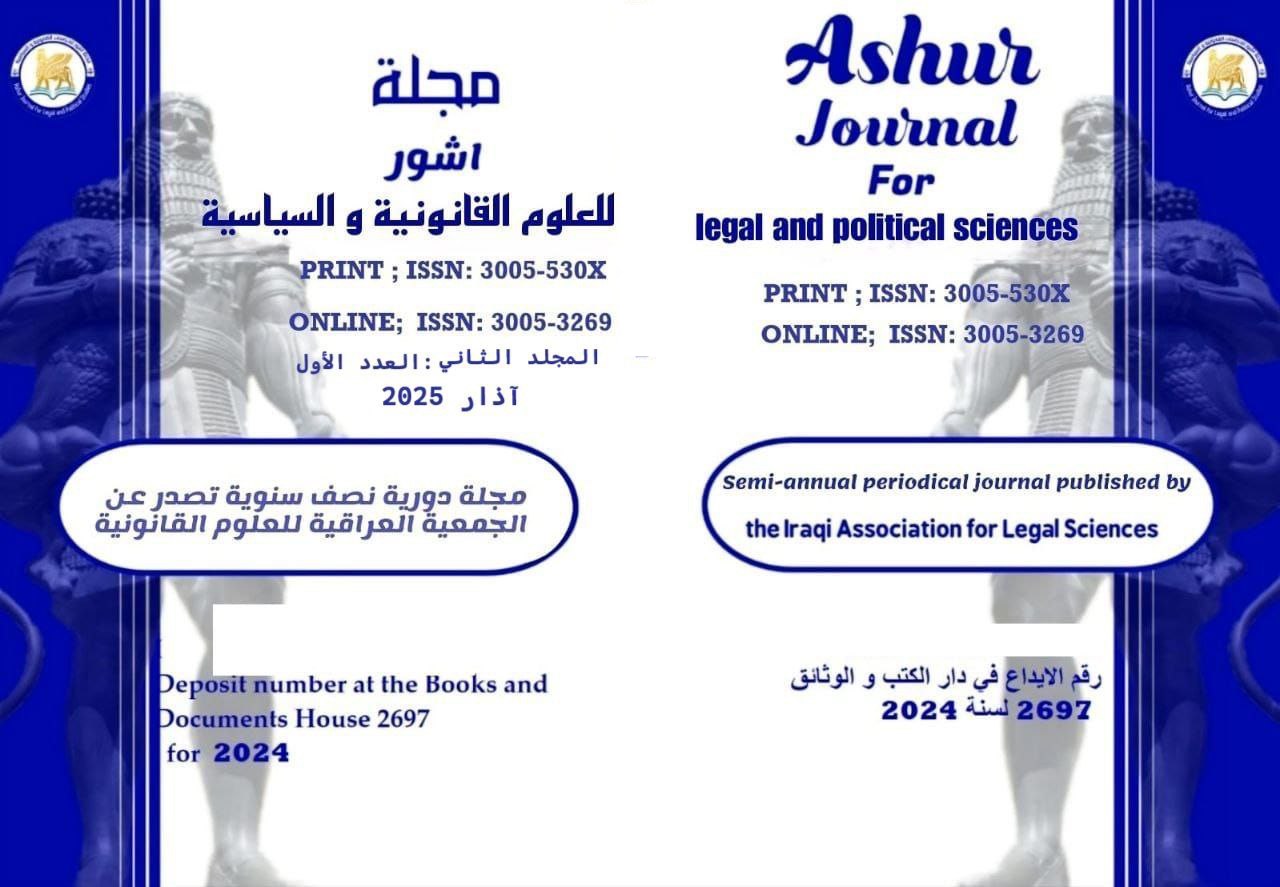Civil protection measures for homeless children from violence
DOI:
https://doi.org/10.64184/ajlps.V2.I1.Y2025.P96-123.17Keywords:
(Legal protection, homeless children, violence).Abstract
The legal protection of homeless children is considered a form of social justice, as its primary aim is to protect human existence. It is also regarded as an acquired right that no longer requires justification, after being established by divine religions, which emphasized the importance of preserving human dignity and rights. This right has been recognized by all laws. Therefore, legal protection, whether constitutional, criminal, or civil, has become a "point of reference" in law, based on the principles of punishment and compensation. It also represents a fundamental element in any legal system that seeks to respect human rights and dignity and to compensate for all forms of harm individuals may face. Despite the state's commitment in Iraq to protect and care for children in general, and homeless children in particular, through legislation aimed at safeguarding and caring for them, violations of the rights and dignity of this vulnerable group continue. This is in the context of rising rates of violence, poverty, family breakdown, and drug abuse. This requires a reevaluation of those laws, identifying weaknesses, and working on establishing legal and procedural mechanisms to address this issue, which has taken a dangerous turn in our society. This is especially true as criminal groups have turned these children into easy tools for carrying out their criminal activities.
References
Sources and References
First - Dictionaries:
1. Bin Zakaria, Abu Al-Hussein, (without year of publication), Language Scales, Vol. 3, Dar Al-Fikr for Printing, Publishing and Distribution, Cairo.
2. Al-Razi, Muhammad, (1981), Mukhtar Al-Sihah, Dar Al-Fikr, Beirut.
3. Al-Ansari, Ibn Manzur, (without year of publication), Lisan Al-Arab, Egyptian House for Authorship and Translation, Cairo.
Second - Legal Books
1. Sultan, Anwar, (1965), General Theory of Obligation, Vol. 1, Sources of Obligation, Dar Al-Maaref.
2. Arafat, Amal, (2016), Unified Child Protection Policy Document for Civil Institutions and Associations Working with Children in Lebanon, Lebanese Ministry of Social Affairs, Abaad Organization and Lebanese Child House Association.
3. Abu Al-Saud, Ramadan, (1984), Principles of Obligation in Egyptian and Lebanese Civil Law, University House for Printing and Publishing, Beirut.
4. Mahmoud, Dhari, (2002), Al-Basit in Explaining the Penal Code - General Section, Publisher Sabah Jaafar, 1st ed.
5. Bahri, Fatima, (2007), Objective Criminal Protection for Child Users, Dar Al-Fikr Al-Jami'i, Alexandria.
6. Al-Sanhouri, Abdul-Razzaq, (1988), Contract Theory, Vol. 3, Al-Halabi Legal Publications, 2nd ed., Lebanon, Beirut.
7. Al-Sadda, Abdul-Moneim, (1979), Sources of Obligation, A Study in Lebanese and Egyptian Law, Dar Al-Nahda Al-Arabiya, Beirut.
8. Awda, Ali, (1977), The Causal Relationship between Error and Harm, Master's Thesis Submitted to the College of Law and Politics, University of Baghdad.
9. Abu Al-Saud, Ramadan, (1984), Principles of Obligation in Egyptian and Lebanese Civil Law, Dar Al-Jami'iyya for Printing and Publishing, Beirut.
10. Al-Bayeh, Mohsen, (1993), The Reality of the Civil Liability Crisis and the Role of Liability Insurance, New Galaa Library, Mansoura.
11. Al-Awji, Mustafa, (1996), Civil Law, Vol. 2, Civil Liability, Bahsoun Foundation for Publishing and Distribution, Beirut.
Third / General Books:
1. Morsi, Abu Bakr, (2001), The Phenomenon of Street Children - Concept - Spread - Responsible Factors - and the Risks Taken, an Uncivilized Vision, Arab Renaissance Library, Cairo.
2. Al-Hassan, Ihsan, (2008), Sociology of Violence and Terrorism, 1st ed., Wael Publishing House, Amman.
3. Fahim, Keller, (2006), Caring for Children - Victims of Domestic Violence, Anglo-Egyptian Library, Cairo.
4. Abada, Madiha, (2008), Violence against Women, 1st ed, Al-Fajr Publishing House, Cairo.
5. Al-Shorbagy, Nabila, (2024), Aggressive Behavior of Street Children, Dar Al-Nahda Al-Arabiya, Cairo.
Fourth / Research:
1. Ghazlani, Widad, (2011), The Role of the United Nations in Combating the Phenomenon of Street Children - Agreements and Mechanisms, Journal of Political and Legal Notebooks, University of May 8, 1945, Guelma, Algeria, Issue 5.
Fifth / Theses and Dissertations:
A / Theses:
1. Shehata, Zainab, (2002), Images of Authority among Street Children and Their Relationship to Some Personality Variables, Master's Thesis Submitted to the Institute of Graduate Studies for Childhood, Department of Psychological and Social Studies, Ain Shams University, Cairo.
B / Theses:
1. Al-Ubaidi, Bushra, (2004), International Criminal Violations of the Rights of the Child, PhD Thesis, University of Baghdad.
2. Mustafa, Qarzan, (2015), The principle of the responsibility to protect and its applications in light of the principles and provisions of international public law, PhD thesis, Faculty of Law and Political Science, Abu Bakr Belkaid University, Tlemcen, Algeria.
Sixth / Electronic sources:
1. The Convention on the Rights of the Child issued by the United Nations in 1989, the United Nations website, published on the link:
https://www.ohchr.org › instruments
2. The World Health Organization, its annual report for the year 2000, published on the Internet website:
3. Rabaa, Iyad, Electronic violence, its causes and ways to confront it, an article published on the website:
https://www.amad.ps/ar/Details/263226
4. The United Nations - ESCO Program, Social Justice, available on the website:
http://www.unescwa.org › social-j.
Seventh / Constitutions and Laws:
A. Constitutions:
B. The current Iraqi Constitution of 2005.
B/ Laws:
1. Iraqi Civil Law No. 40 of 1951.
2. Current Iraqi Personal Status Law No. (188) of 1959.
3. Iraqi Penal Code No. (111) of 1969.
4. Minors Care Law No. 78 of 1980.
Downloads
Published
Issue
Section
License
The authors retain Full copyright of their published article
Ashur Journal of Legal and Political Sciences applies the Creative Commons Attribution 4.0 International (CC BY 4.0) License to articles and other works we publish. If you submit your paper for publication by AJLPS, you agree to have the CC BY 4.0 license applied to your work.
Articles can be read and shared for under the following conditions:
BY: Attribution must be given to the original source (Attribution)
Full details available at
https://creativecommons.org/licenses/by/4.0/






